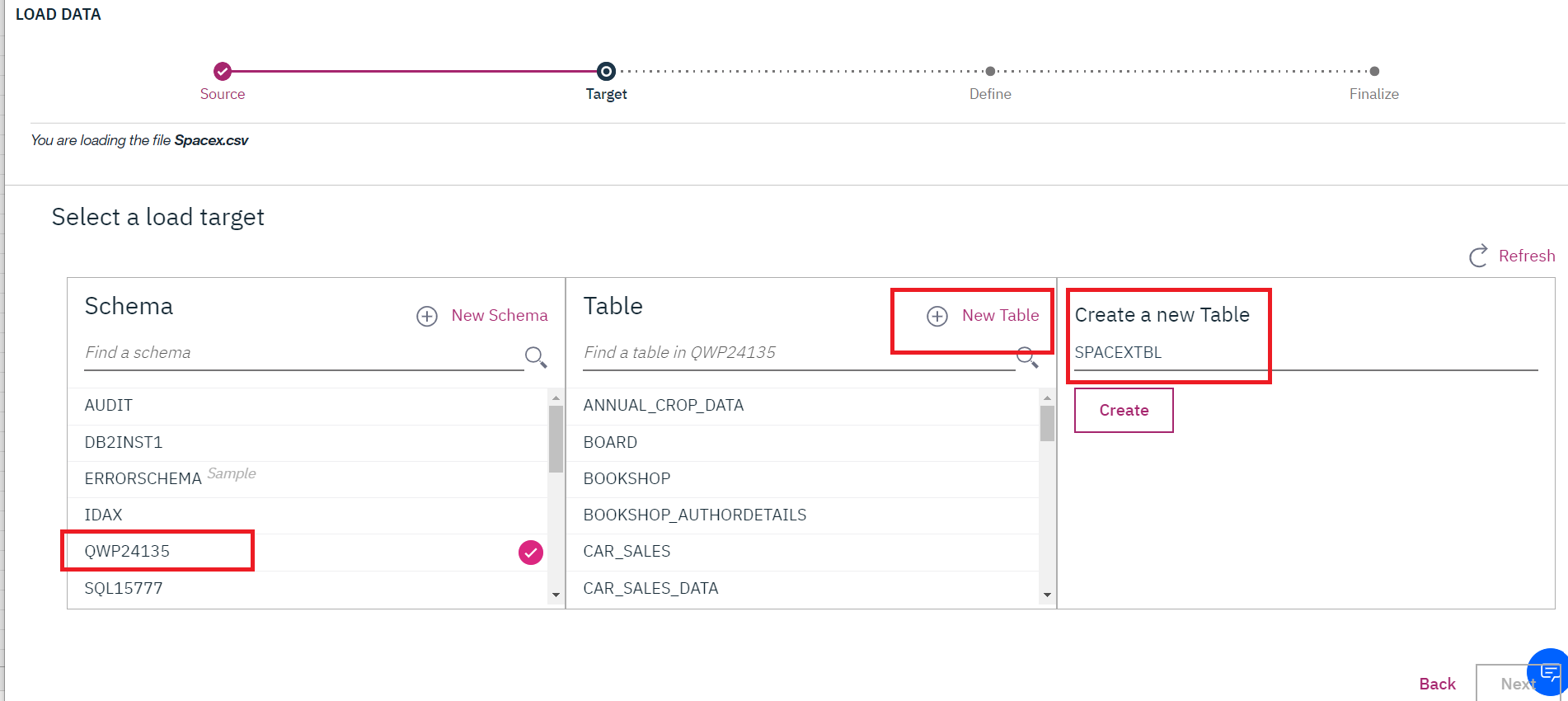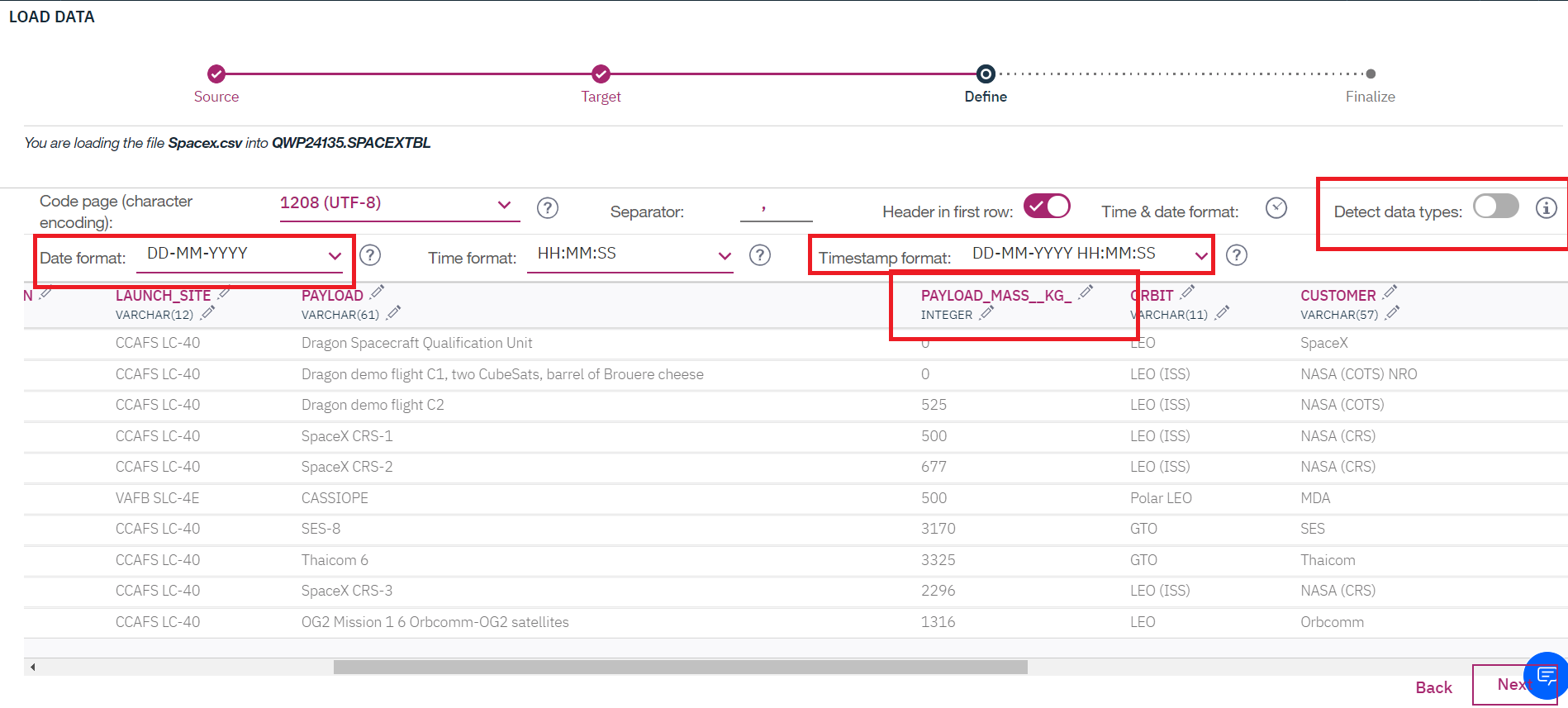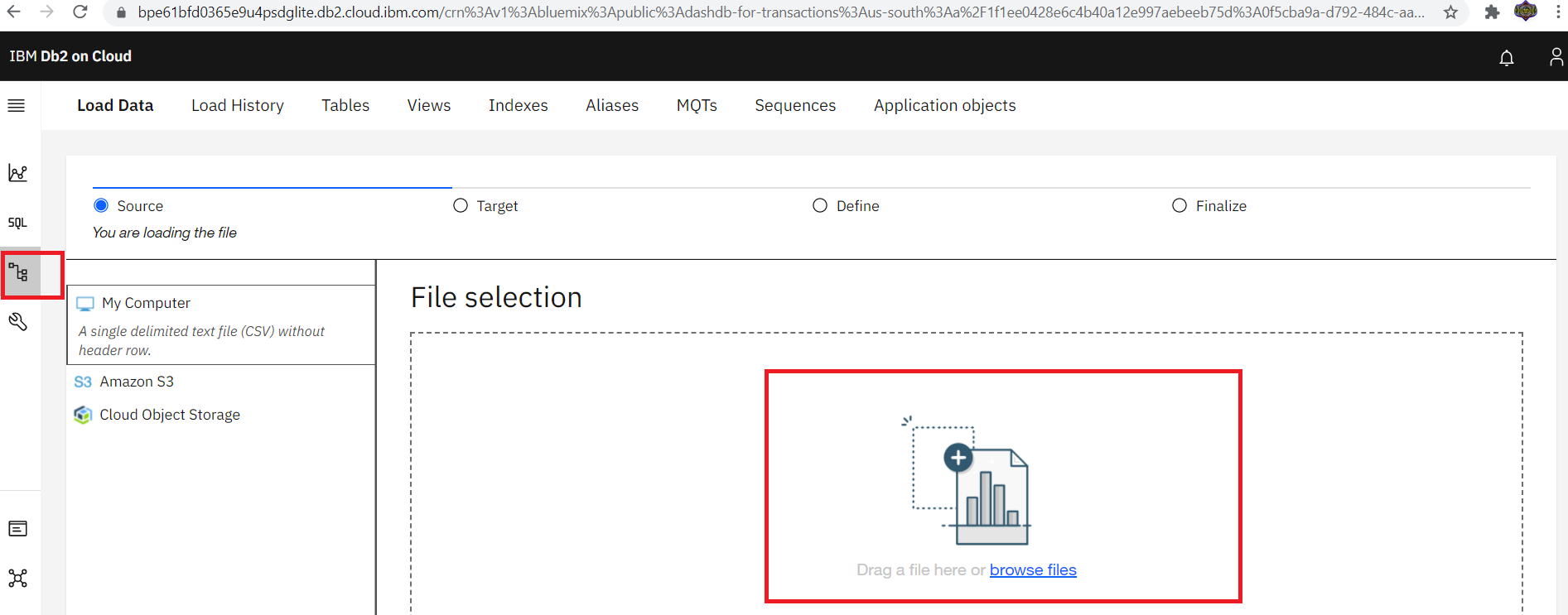Estimated time needed: 60 minutes.
Using this Python notebook you will:
- Understand the Spacex DataSet
- Load the dataset into the corresponding table in a Db2 database
- Execute SQL queries to answer assignment questions
SpaceX has gained worldwide attention for a series of historic milestones.
It is the only private company ever to return a spacecraft from low-earth orbit, which it first accomplished in December 2010. SpaceX advertises Falcon 9 rocket launches on its website with a cost of 62 million dollars wheras other providers cost upward of 165 million dollars each, much of the savings is because Space X can reuse the first stage.
Therefore if we can determine if the first stage will land, we can determine the cost of a launch.
This information can be used if an alternate company wants to bid against SpaceX for a rocket launch.
This dataset includes a record for each payload carried during a SpaceX mission into outer space.
This assignment requires you to load the spacex dataset.
In many cases the dataset to be analyzed is available as a .CSV (comma separated values) file, perhaps on the internet. Click on the link below to download and save the dataset (.CSV file):
it is highly recommended to manually load the table using the database console LOAD tool in DB2.
Now open the Db2 console, open the LOAD tool, Select / Drag the .CSV file for the dataset, Next create a New Table, and then follow the steps on-screen instructions to load the data. Name the new table as follows:
SPACEXDATASET
Follow these steps while using old DB2 UI which is having Open Console Screen
Note:While loading Spacex dataset, ensure that detect datatypes is disabled. Later click on the pencil icon(edit option).
-
Change the Date Format by manually typing DD-MM-YYYY and timestamp format as DD-MM-YYYY HH:MM:SS
-
Change the PAYLOAD_MASS__KG_ datatype to INTEGER.
Changes to be considered when having DB2 instance with the new UI having Go to UI screen
-
Refer to this insruction in this link for viewing the new Go to UI screen.
-
Later click on Data link(below SQL) in the Go to UI screen and click on Load Data tab.
-
Later browse for the downloaded spacex file.
- Once done select the schema andload the file.
!pip install sqlalchemy==1.3.9Collecting sqlalchemy==1.3.9
Downloading SQLAlchemy-1.3.9.tar.gz (6.0 MB)
�[2K �[90m━━━━━━━━━━━━━━━━━━━━━━━━━━━━━━━━━━━━━━━━�[0m �[32m6.0/6.0 MB�[0m �[31m83.6 MB/s�[0m eta �[36m0:00:00�[0m:00:01�[0m00:01�[0m
�[?25h Preparing metadata (setup.py) ... �[?25ldone
�[?25hBuilding wheels for collected packages: sqlalchemy
Building wheel for sqlalchemy (setup.py) ... �[?25ldone
�[?25h Created wheel for sqlalchemy: filename=SQLAlchemy-1.3.9-cp37-cp37m-linux_x86_64.whl size=1159122 sha256=4ca84e6075c8a4fc6b1dc82bbfa731f748db43aeefb704e9f6bade028052d2f8
Stored in directory: /home/jupyterlab/.cache/pip/wheels/ef/95/ac/c232f83b415900c26553c64266e1a2b2863bc63e7a5d606c7e
Successfully built sqlalchemy
Installing collected packages: sqlalchemy
Attempting uninstall: sqlalchemy
Found existing installation: SQLAlchemy 1.3.24
Uninstalling SQLAlchemy-1.3.24:
Successfully uninstalled SQLAlchemy-1.3.24
Successfully installed sqlalchemy-1.3.9
Let us first load the SQL extension and establish a connection with the database
%load_ext sqlimport csv, sqlite3
con = sqlite3.connect("my_data1.db")
cur = con.cursor()!pip install -q pandas==1.1.5%sql sqlite:///my_data1.db'Connected: @my_data1.db'
import pandas as pd
df = pd.read_csv("https://cf-courses-data.s3.us.cloud-object-storage.appdomain.cloud/IBM-DS0321EN-SkillsNetwork/labs/module_2/data/Spacex.csv")
df.to_sql("SPACEXTBL", con, if_exists='replace', index=False,method="multi")/home/jupyterlab/conda/envs/python/lib/python3.7/site-packages/pandas/core/generic.py:2882: UserWarning: The spaces in these column names will not be changed. In pandas versions < 0.14, spaces were converted to underscores.
both result in 0.1234 being formatted as 0.12.
Now write and execute SQL queries to solve the assignment tasks.
Note: If the column names are in mixed case enclose it in double quotes For Example "Landing_Outcome"
%%sql
Select DISTINCT(launch_site) FROM SPACEXTBL * sqlite:///my_data1.db
Done.
| Launch_Site |
|---|
| CCAFS LC-40 |
| VAFB SLC-4E |
| KSC LC-39A |
| CCAFS SLC-40 |
%%sql
Select * FROM SPACEXTBL
WHERE launch_site LIKE '%CCA%'
LIMIT 5; * sqlite:///my_data1.db
Done.
| Date | Time (UTC) | Booster_Version | Launch_Site | Payload | PAYLOAD_MASS__KG_ | Orbit | Customer | Mission_Outcome | Landing _Outcome |
|---|---|---|---|---|---|---|---|---|---|
| 04-06-2010 | 18:45:00 | F9 v1.0 B0003 | CCAFS LC-40 | Dragon Spacecraft Qualification Unit | 0 | LEO | SpaceX | Success | Failure (parachute) |
| 08-12-2010 | 15:43:00 | F9 v1.0 B0004 | CCAFS LC-40 | Dragon demo flight C1, two CubeSats, barrel of Brouere cheese | 0 | LEO (ISS) | NASA (COTS) NRO | Success | Failure (parachute) |
| 22-05-2012 | 07:44:00 | F9 v1.0 B0005 | CCAFS LC-40 | Dragon demo flight C2 | 525 | LEO (ISS) | NASA (COTS) | Success | No attempt |
| 08-10-2012 | 00:35:00 | F9 v1.0 B0006 | CCAFS LC-40 | SpaceX CRS-1 | 500 | LEO (ISS) | NASA (CRS) | Success | No attempt |
| 01-03-2013 | 15:10:00 | F9 v1.0 B0007 | CCAFS LC-40 | SpaceX CRS-2 | 677 | LEO (ISS) | NASA (CRS) | Success | No attempt |
%%sql
SELECT SUM(PAYLOAD_MASS__KG_) FROM SPACEXTBL
WHERE Customer LIKE "%(CRS)%" * sqlite:///my_data1.db
Done.
| SUM(PAYLOAD_MASS__KG_) |
|---|
| 48213 |
%%sql
SELECT AVG(PAYLOAD_MASS__KG_) FROM SPACEXTBL
WHERE Booster_Version LIKE '%F9 v1.1%'; * sqlite:///my_data1.db
Done.
| AVG(PAYLOAD_MASS__KG_) |
|---|
| 2534.6666666666665 |
Hint:Use min function
%%sql
SELECT DATE, [Landing _Outcome] FROM SPACEXTBL
where (substr(DATE,7)||substr(DATE,4,2)||substr(DATE,1,2)
between '20100604' and '20171130') AND [Landing _Outcome] LIKE "%Success (ground pad)%"
LIMIT 1; * sqlite:///my_data1.db
Done.
| Date | Landing _Outcome |
|---|---|
| 22-12-2015 | Success (ground pad) |
List the names of the boosters which have success in drone ship and have payload mass greater than 4000 but less than 6000
%%sql
SELECT Booster_Version FROM SPACEXTBL
Where PAYLOAD_MASS__KG_ >4000 AND PAYLOAD_MASS__KG_ <6000
AND"Landing _Outcome" LIKE '%Success (drone ship)%'; * sqlite:///my_data1.db
Done.
| Booster_Version |
|---|
| F9 FT B1022 |
| F9 FT B1026 |
| F9 FT B1021.2 |
| F9 FT B1031.2 |
%%sql
SELECT Mission_Outcome,COUNT(*) FROM SPACEXTBL
Group by Mission_Outcome; * sqlite:///my_data1.db
Done.
| Mission_Outcome | COUNT(*) |
|---|---|
| Failure (in flight) | 1 |
| Success | 98 |
| Success | 1 |
| Success (payload status unclear) | 1 |
%%sql
Select MAX(PAYLOAD_MASS__KG_) FROM SPACEXTBL * sqlite:///my_data1.db
Done.
| MAX(PAYLOAD_MASS__KG_) |
|---|
| 15600 |
%%sql
SELECT Distinct(Booster_version),(PAYLOAD_MASS__KG_) as "Payload" FROM SPACEXTBL
Where PAYLOAD_MASS__KG_=(Select MAX(PAYLOAD_MASS__KG_) FROM SPACEXTBL); * sqlite:///my_data1.db
Done.
| Booster_Version | Payload |
|---|---|
| F9 B5 B1048.4 | 15600 |
| F9 B5 B1049.4 | 15600 |
| F9 B5 B1051.3 | 15600 |
| F9 B5 B1056.4 | 15600 |
| F9 B5 B1048.5 | 15600 |
| F9 B5 B1051.4 | 15600 |
| F9 B5 B1049.5 | 15600 |
| F9 B5 B1060.2 | 15600 |
| F9 B5 B1058.3 | 15600 |
| F9 B5 B1051.6 | 15600 |
| F9 B5 B1060.3 | 15600 |
| F9 B5 B1049.7 | 15600 |
List the records which will display the month names, failure landing_outcomes in drone ship ,booster versions, launch_site for the months in year 2015.
Note: SQLLite does not support monthnames. So you need to use substr(Date, 4, 2) as month to get the months and substr(Date,7,4)='2015' for year.
%%sql
SELECT CASE cast(SUBSTR(DATE,4,2) as integer)
WHEN "01" THEN "January"
WHEN "02" THEN "February"
WHEN "03" THEN "March"
WHEN "04" THEN "April"
WHEN "05" THEN "May"
WHEN "06" THEN "June"
WHEN "07" THEN "July"
WHEN "08" THEN "August"
WHEN "09" THEN "September"
WHEN "10" THEN "October"
WHEN "11" THEN "November"
WHEN "12" THEN "December"
END as "month",
Date,Launch_site, Booster_Version,[Landing _Outcome]
FROM SPACEXTBL
WHERE [Landing _Outcome] = "Failure (drone ship)" AND substr(Date,7,4)='2015'
* sqlite:///my_data1.db
Done.
| month | Date | Launch_Site | Booster_Version | Landing _Outcome |
|---|---|---|---|---|
| January | 10-01-2015 | CCAFS LC-40 | F9 v1.1 B1012 | Failure (drone ship) |
| April | 14-04-2015 | CCAFS LC-40 | F9 v1.1 B1015 | Failure (drone ship) |
Rank the count of successful landing_outcomes between the date 04-06-2010 and 20-03-2017 in descending order.
%%sql
SELECT [Landing _Outcome],COUNT([Landing _Outcome]) "Missions", RANK() OVER( ORDER BY COUNT([Landing _Outcome]) DESC) Rank FROM SPACEXTBL
where (substr(DATE,7)||substr(DATE,4,2)||substr(DATE,1,2)
between '20100604' and '20170320') AND [Landing _Outcome] LIKE "%Success%"
Group by [Landing _Outcome]; * sqlite:///my_data1.db
Done.
| Landing _Outcome | Missions | Rank |
|---|---|---|
| Success (drone ship) | 5 | 1 |
| Success (ground pad) | 3 | 2 |
| Date | Version | Changed by | Change Description |
|---|---|---|---|
| 2021-07-09 | 0.2 | Lakshmi Holla | Changes made in magic sql |
| 2021-05-20 | 0.1 | Lakshmi Holla | Created Initial Version |




